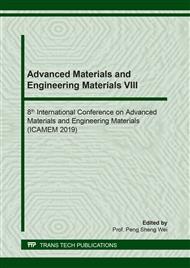[1]
W.C. Du, X.L. Pu, J.S. Sun, et al. A novel monomeric amine as sodium montmorillonite swelling inhibitor [J]. Adsorpt. Sci. Technol. 36(2018) 655-668.
DOI: 10.1177/0263617417713851
Google Scholar
[2]
S.H. Zhang, W.C. Du, F.S. Liang. Synthesis and characterization of glycidyl allyl dimethyl ammonium chloride (GADAC) [C]. Adv. Mater. Res. 554-556(2012) 783-786.
DOI: 10.4028/www.scientific.net/amr.554-556.783
Google Scholar
[3]
S.H. Gou, T. Yin, K. Liu, et al. Water-soluble complexes of an acrylamide copolymer and ionic liquids for inhibiting shale hydration[J]. New J. Chem. 39 (2015) 2155-2161.
DOI: 10.1039/c4nj01741b
Google Scholar
[4]
X.J. Liu, K. Liu, S.H. Gou, et al. Water-soluble acrylamide sulfonate copolymer for inhibiting shale hydration[J]. Ind Eng Chem Res. 53 (2014) 2903-2910.
DOI: 10.1021/ie403956d
Google Scholar
[5]
R. Jain, V. Mahto. Evaluation of polyacrylamide/claycomposite as a potential drilling fluid additive in inhibitive water based drilling fluid system[J]. J. Pet. Sci. Eng. 133 (2015) 612–621.
DOI: 10.1016/j.petrol.2015.07.009
Google Scholar
[6]
E.S. Boek, P.V. Coveney, N.T. Skipper. Monte carlo molecular modeling studies of hydrated Li-, Na-,and K-Smectites: understanding the role of potassium as a clay swelling inhibitor[J]. J. Am. Chem. Soc. 117(1995) 12608-12617.
DOI: 10.1021/ja00155a025
Google Scholar
[7]
G. Chen, J. Zhang, N.W. Yang, et al. The evaluation of sodium hydroxymethyl lignosulfonate as an ecofriendly drilling fluid additive[J]. Petrol. Sci. Technol. 32(2014) 1816-1823.
DOI: 10.1080/10916466.2011.642916
Google Scholar
[8]
N. Sarier, E. Onder, S. Ersoy. The modification of Na-montmorillonite by salts of fatty acids: An easy intercalation process[J]. Colloids Surf. A. 371 (2010) 40-49.
DOI: 10.1016/j.colsurfa.2010.08.061
Google Scholar
[9]
F. Salles, J.M. Douilard, O Bildstien, et al. Driving force for the hydration of the swelling clays: case of montmorillonites saturated with alkaline-earth cations[J]. J. Colloid Interf. Sci. 395 (2013) 269-276.
DOI: 10.1016/j.jcis.2012.12.050
Google Scholar
[10]
Y. Xuan, G.C. Jiang, Y.Y. Li, et al. Inhibiting effect of dopamine adsorption and polymerization on hydrated swelling of montmorillonite[J]. Colloids Surf. A. 422 (2013) 50-60.
DOI: 10.1016/j.colsurfa.2013.01.038
Google Scholar


